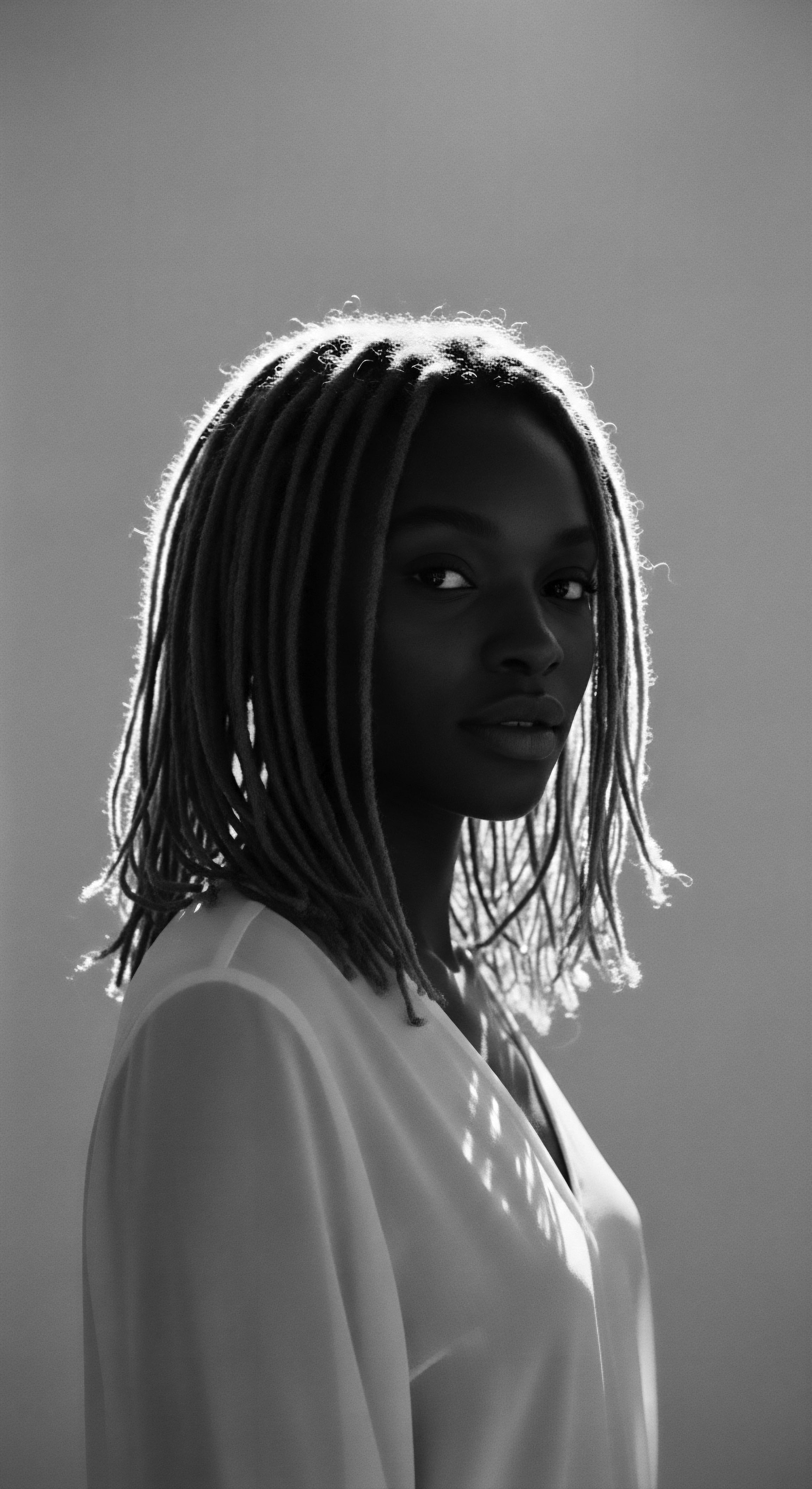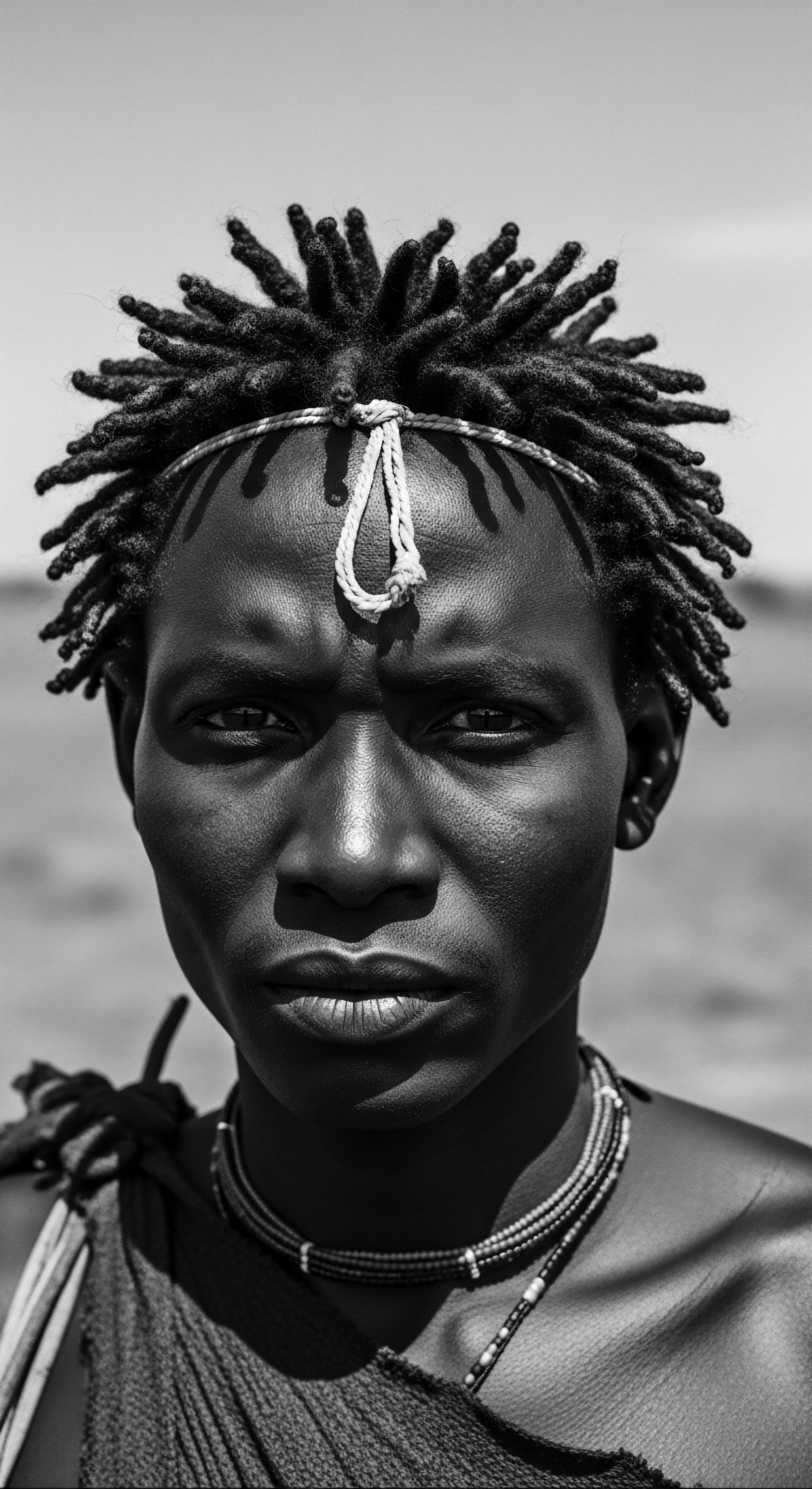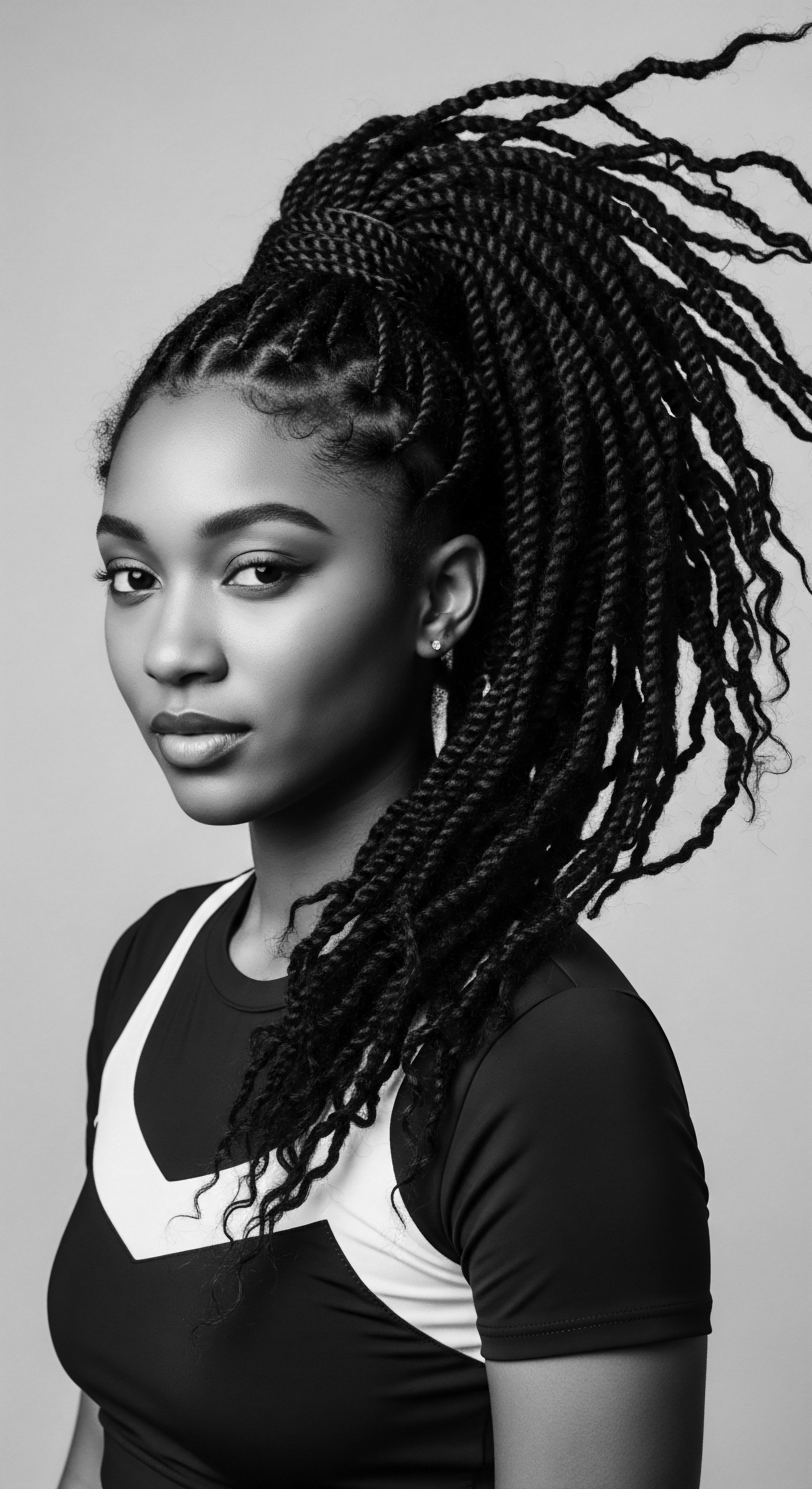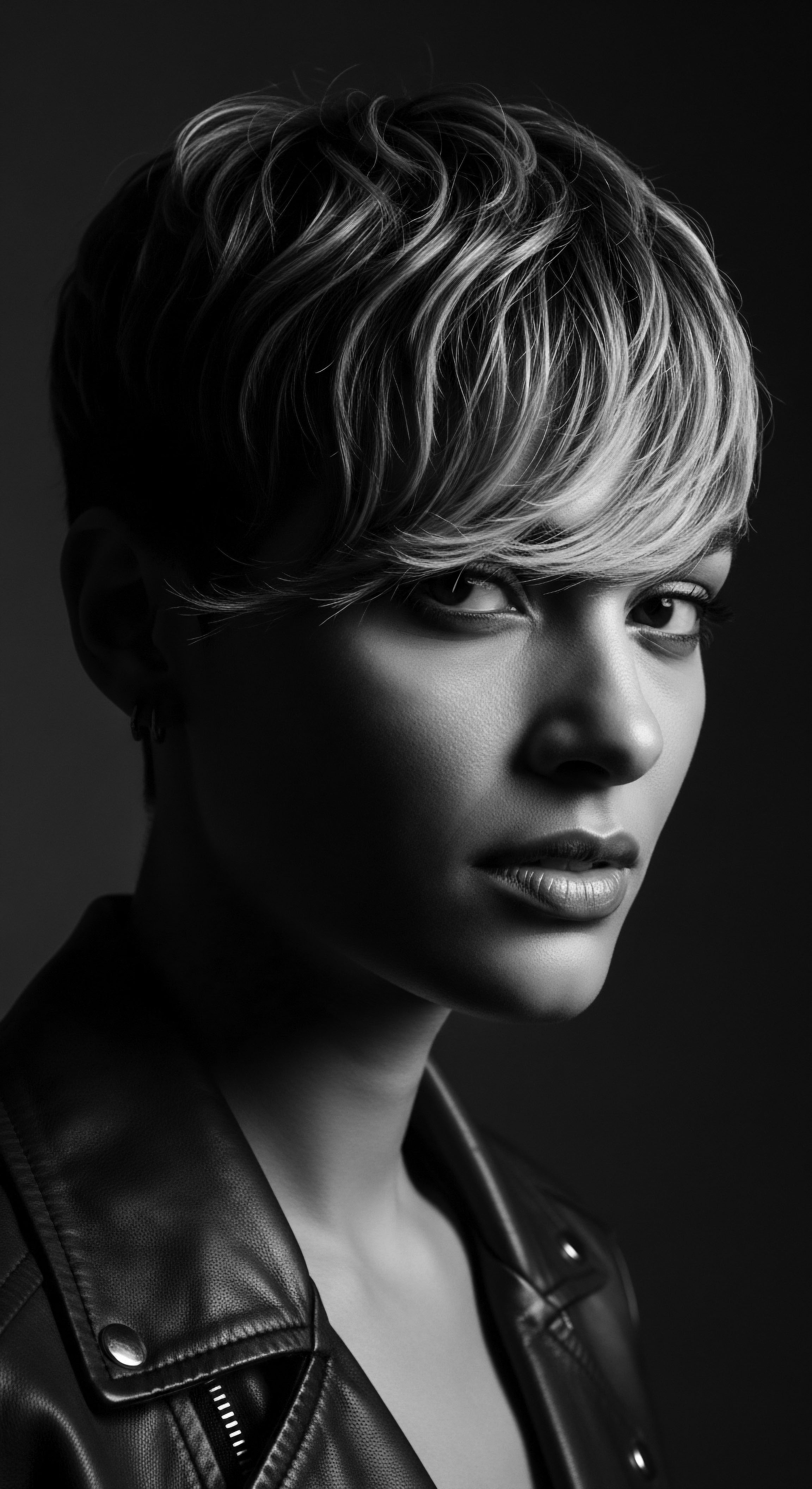
Roots
To journey into the meaning of hair coverings for Black heritage is to step into a living archive, where each fold of fabric, every carefully wrapped coil, speaks volumes of endurance, beauty, and identity. It is an invitation to listen to the whispers of our ancestors, feeling the deep resonance of their practices within our own strands. Hair, particularly textured hair, has never been a mere biological appendage for Black people; it has always been a profound extension of self, community, and spiritual connection. This ancestral reverence for hair meant its adornment and protection were far more than superficial acts.
They were cultural statements, often imbued with layers of meaning, from social standing to spiritual devotion. The story of hair coverings begins long before the transatlantic crossings, in the vibrant civilizations of Africa where elaborate coiffures and head adornments marked a person’s place in the world.

Ancestral Crowns and Coverings
In many pre-colonial African societies, hair was a powerful marker, communicating details about an individual’s identity without a single word spoken. A person’s hairstyle could signify their age, marital status, social rank, wealth, religious beliefs, or even their tribal affiliation. Head coverings, in these contexts, were often extensions of these intricate hair designs, adding further layers of symbolism and protection.
For instance, in West African cultures, head wraps often conveyed a woman’s marital status, mourning period, or elevated social standing. Royal women in ancient Egypt, Nigeria, and Nubia wore head wraps not only for aesthetic appeal but also for practical reasons like shielding themselves from the sun.
Hair coverings for Black heritage echo ancient African practices, embodying identity, status, and spiritual connection through generations.
The meticulous care and styling of hair was a communal ritual, a time for bonding and sharing stories. This communal aspect extended to the use of coverings, which were chosen with intention, reflecting the values and aesthetics of specific groups. These practices underscore how deeply hair and its adornment were interwoven with daily life and cultural expression on the continent.
The very act of styling hair was a social ritual, sometimes taking hours or even days, allowing for intergenerational connection. (Byrd & Tharps, 2001)

The Textured Hair’s Resilience
Textured hair, with its unique helical structure, holds moisture differently and requires specific care, a knowledge passed down through generations. The inherent qualities of coily, kinky, and curly hair meant that protective measures were not simply optional; they were essential for maintenance and health. Head coverings served as a primary means of shielding these delicate structures from environmental elements, dust, and harsh sun.
In African societies, rural women often used head wraps as protective clothing to cover hair while doing chores. This practical application was always accompanied by an aesthetic sensibility, where beauty and utility moved in concert.
The resilience of textured hair, its capacity to be styled in countless ways while retaining its inherent strength, found a natural complement in the versatility of head coverings. These coverings often augmented existing hairstyles, acting as a final layer of adornment or a protective cocoon. The understanding of hair anatomy, from the tight curl patterns to the delicate cuticle layers, informed these ancestral practices.
The lexicon surrounding textured hair and its coverings is rich and varied across the African continent and diaspora.
- Gele ❉ A term for head wraps in Yoruba-speaking parts of Nigeria, often elaborately folded.
- Duku ❉ Used in Ghana or Malawi for head wraps, typically tied with a knot.
- Doek ❉ An Afrikaans word common in South Africa and Namibia for head coverings.
These terms underscore the localized cultural significance and adaptation of hair covering practices. Each name carries the weight of a particular history and community, defining how these coverings are worn and perceived within their respective cultural contexts.

Ritual
The journey of hair coverings for Black heritage took a stark turn during the transatlantic slave trade, transforming from a symbol of cultural pride and status into a badge of subjugation. Enslaved Africans, forcibly removed from their homelands, experienced a deliberate campaign to strip them of their cultural markers, including their elaborate hairstyles and accompanying coverings. The shaving of heads upon arrival was a brutal act of dehumanization, a severance from identity and lineage. Yet, even in the face of such profound oppression, the spirit of resilience found expression through hair, and crucially, through the very coverings imposed upon them.

From Imposed Uniform to Secret Language
In the Americas, particularly during slavery, white enslavers mandated head coverings for Black women. These headscarves, often made from the cheapest fabrics, were intended as markers of inferiority, signs of servile status. They served practical purposes, protecting hair from sun, sweat, grime, and lice in the harsh conditions of forced labor.
Hair coverings in the diaspora became a complex visual dialogue, intertwining suppression with fierce acts of identity reclamation.
However, Black women, with extraordinary ingenuity, transformed these symbols of oppression into a quiet rebellion, a means of preserving their inherent dignity and cultural connection. The head wrap, or “tignon” in Louisiana, provides a poignant case study. In 1786, Spanish colonial Governor Esteban Rodriguez Miró enacted the Tignon Laws in New Orleans, requiring free women of color to cover their hair with a tignon, aiming to undermine their “excessive attention to dress” and diminish their allure to white men. This legal imposition sought to regulate their appearance and reinforce social hierarchies.
Yet, what began as a tool of control became a canvas of defiance. Afro-Creole women responded by decorating their tignons with vibrant colors, luxurious fabrics, jewels, and feathers, tying them with elaborate, ornate knots. This act transformed the tignon from a badge of dishonor into a powerful statement of beauty, wealth, and creativity, a subtle yet profound protest against colonial authority.
Historian Carolyn Long observed that the imaginative wrapping techniques enhanced the beauty of women of color, effectively turning a symbol of inferiority into a fashion statement. This creative resistance, a silent but potent language, continued through coded messages woven into the folds of headscarves, particularly in places like Suriname, where such techniques facilitated communication among enslaved people.

The Legacy of Protective Styling
The practical application of hair coverings as protective styling, deeply rooted in ancestral African methods, continued through the diaspora. The realities of maintaining textured hair under challenging conditions meant that keeping hair covered, particularly at night, was a necessity for preserving styles and hair health. This utilitarian aspect sustained certain elements of ancestral hair care traditions even as others were suppressed.
| Historical Context Pre-colonial Africa |
| Meaning/Function Indicated social status, age, marital status, spiritual beliefs, tribal identity; practical protection from elements. |
| Historical Context Slavery in the Americas |
| Meaning/Function Initially imposed as a symbol of servitude and inferiority; transformed by wearers into a tool of cultural preservation, resistance, and coded communication. |
| Historical Context Post-Emancipation (Early 20th Century) |
| Meaning/Function Associated with domestic labor and practicality; sometimes abandoned for assimilation into Eurocentric beauty standards. |
| Historical Context Civil Rights & Black Power Era (1960s-70s) |
| Meaning/Function Reclaimed as a powerful emblem of Black pride, cultural heritage, and political resistance. |
| Historical Context Contemporary Era |
| Meaning/Function Continues as a fashion statement, cultural affirmation, protective style, and spiritual practice, linking modern wearers to ancestral roots. |
| Historical Context Hair coverings have consistently mirrored the complex historical journey of Black heritage, shifting from inherent cultural expression to symbols of resistance and, ultimately, reclamation. |

How Did Hair Coverings Become Symbols of Resistance?
The transformation of hair coverings into symbols of resistance emerged from a profound need to defy dehumanization and assert inherent worth. When forced to cover their hair, Black women deliberately styled their head wraps with intention, using color, texture, and tying methods to express identity, status, and even dissent. The bold adoption of elaborate and colorful wraps, as seen with the Tignon Laws, directly contradicted the oppressive intent of the laws, rendering the coverings a statement of individuality and a challenge to imposed inferiority. These acts of styling became quiet but powerful declarations of selfhood in a world that sought to deny it.
This period also witnessed the practical adoption of silk and satin scarves for nighttime hair protection. As chemical relaxers gained popularity in the early 20th century, allowing for straightened hairstyles, women used these coverings to preserve their pressed hair from sweat and humidity overnight. This practical application, while seemingly mundane, speaks to a consistent effort to maintain hair health and appearance, a practice that sustained a connection to ancestral care philosophies, even if the primary styling method was influenced by Eurocentric beauty standards. The underlying principle of protecting delicate textured strands, whether pressed or natural, remained a constant.

Relay
The historical meaning of hair coverings for Black heritage extends beyond moments of oppression and resistance; it speaks to a continuous relay of ancestral wisdom, adapting and finding new expressions across generations. The mid-20th century, particularly the Civil Rights and Black Power movements, witnessed a profound resurgence in the conscious embrace of textured hair and, with it, the symbolic power of head coverings. This period marked a powerful cultural renaissance, where rejecting Eurocentric beauty standards became a political act, and celebrating Afro-textured hair was a declaration of self-love and racial pride.

Reclaiming the Crown ❉ Post-Civil Rights Affirmation
During the 1960s and 1970s, the Afro hairstyle emerged as a defiant statement against societal norms, becoming a strong symbol of Black unity and pride. Alongside this, head wraps were consciously reclaimed as a central accessory of this rebellion. The head wrap, like the Afro, openly embraced a style once used to shame people of African descent, transforming it into an Afrocentric aesthetic celebration. Kente cloth headwraps, in particular, became a symbol of this cultural affirmation.
From ancient practicalities to modern declarations, hair coverings continue to tell stories of Black heritage.
This period solidified the head wrap’s status as a visual language of identity, resilience, and pride, materially linking Black women in the West with their ancestors and continental cousins. The choice to wear a head wrap became a conscious act of cultural heritage, a nod to a deep lineage, a shield in environments that misunderstood, and a form of self-love. It represents an unspoken connection to every woman who came before, a bold statement to the world.

What Role do Head Coverings Play in Modern Textured Hair Care and Identity?
In contemporary times, hair coverings hold multifaceted meanings, blending historical significance with modern practicality and personal expression. They serve as essential components of holistic textured hair care regimens. The silk bonnet or scarf, for instance, protects hair at night, reducing friction, preserving moisture, and minimizing tangles, which are common concerns for textured strands.
This practice, while informed by modern hair science, echoes the ancestral understanding of hair protection. The emphasis on gentle care, moisture retention, and minimal manipulation aligns perfectly with the needs of highly textured hair.
Consider the widespread adoption of bonnets and silk/satin pillowcases within the Black community. While bonnets have historical roots in European fashion, their necessity for Black women during slavery, particularly for protecting hair, led to their practical and cultural adoption. Today, this seemingly simple act of covering hair at night is a cornerstone of maintaining hair health, preventing breakage and dryness that cotton pillowcases might cause. This nightly ritual is a direct link to an enduring concern for hair wellness, connecting daily care to a deep, inherited wisdom.
Moreover, modern hair coverings are integral to:
- Protective Styling Longevity ❉ Extending the life of styles like braids, twists, and locs by minimizing exposure to environmental stressors.
- Moisture Retention ❉ Materials like silk and satin help prevent moisture loss, crucial for preventing dryness in textured hair.
- Friction Reduction ❉ Limiting friction against rough surfaces (like cotton pillowcases) that can lead to frizz and breakage.
These practical benefits underscore a scientific understanding of textured hair’s needs, often validating long-standing traditional care practices rooted in ancestral wisdom.

The Continuous Narrative of Hair Coverings
The meaning of hair coverings also extends into spiritual and religious practices. In various traditional African religions, head coverings are worn for specific ceremonies or to denote a spiritual initiate. For Black Muslim women, the hijab is an act of faith, yet its wear is also part of a wider story of what covering signifies for women across the African diaspora, encompassing cultural and ancestral layers. (Munu, 2019) This confluence of spiritual adherence and cultural legacy reflects the complex identity woven into each wrap.
The journey of hair coverings for Black heritage is a testament to cultural survival and creative adaptation. From ancient royal adornments in Africa to enforced symbols of servitude, then to defiant acts of resistance and, finally, to modern expressions of identity and self-care, the fabric on the head has always carried profound meaning. It speaks to a deep connection to ancestry, a vibrant cultural legacy, and the ongoing conversation between past and present in the landscape of Black and mixed-race hair. It serves as a visual reminder of the ingenuity and resilience that allowed a people to sustain their identity even when facing immense pressure to conform.
| Element Color |
| Ancestral/Diasporic Significance Specific hues could denote mourning, celebration, marital status, or even tribal affiliation in various African cultures. |
| Element Style/Tying Method |
| Ancestral/Diasporic Significance Variations in wraps indicated social standing, regional origin, or conveyed coded messages during periods of oppression. |
| Element Fabric Choice |
| Ancestral/Diasporic Significance Rich, ornate fabrics signaled wealth and status in pre-colonial societies; later, creative use of available materials during slavery became a form of protest. |
| Element The language of hair coverings has always been rich with non-verbal communication, speaking volumes about the wearer and their community. |
One particularly resonant historical example that powerfully illuminates the connection of hair coverings to textured hair heritage and Black experience is the Tignon Laws of Louisiana in 1786. This law, mandated by Spanish colonial Governor Esteban Rodriguez Miró, required free women of color in New Orleans to cover their hair with a tignon—a turban-like headwrap. The stated intent was to mark them as belonging to the slave class, regardless of their free status, and to control their perceived beauty which attracted white men and threatened the social order. However, these women, instead of complying in shame, adorned their tignons with exquisite fabrics, jewels, and feathers, tying them in elaborate styles that ultimately enhanced their beauty and became a symbol of defiance and creativity.
This act transformed an instrument of oppression into a potent visual declaration of identity and resistance. It demonstrates a profound resilience, turning mandated inferiority into an expression of inherent dignity. The Tignon Laws highlight how the very hair that was targeted for control became the site of a profound, stylish rebellion, showcasing the enduring spirit of self-determination within Black heritage.

Reflection
As we close this dialogue, we are left with a deeper sense of what hair coverings truly mean for Black heritage. They are more than adornment or simple coverings; they are living testaments, chapters in an ongoing story written across centuries and continents. Each wrapped head, whether in the vibrant streets of Accra or the bustling avenues of a Western city, carries echoes of ancient practices and whispers of resilient defiance. The spirit of the ‘Soul of a Strand’ resonates here, reminding us that every coil and every carefully placed fold holds history, wisdom, and a profound connection to ancestry.
The journey of these coverings, from symbols of status and spirituality to tools of resistance against chattel slavery, then reclaimed as powerful emblems of identity, underscores a continuum of strength and cultural rootedness. This enduring legacy prompts us to recognize that our care rituals today, from the simple bonnet donned at night to the elaborate headwrap worn for celebration, are not isolated acts. They are threads woven into a grand narrative, connecting us to those who came before, validating their struggles, and celebrating their triumphs.
We become participants in this living library, preserving the knowledge, the beauty, and the profound meaning embedded in every strand and every covering. This lineage, ever vibrant, ever evolving, continues to guide our understanding of self and belonging.

References
- Byrd, A. & Tharps, L. (2001). Hair Story ❉ Untangling the Roots of Black Hair in America. St. Martin’s Press.
- Munu, A. J. (2019). Allah, Asè and Afros. In Critical Muslim (Vol. 30).
- Griebel, H. B. (1994). The African American Woman’s Headwrap ❉ Unwinding the Symbols. Art, Design, and Visual Thinking.
- Sherrow, V. (2006). Encyclopedia of Hair ❉ A Cultural History. Greenwood Press.
- Gordon, M. (2016). African Hair ❉ The History of Black Hair, A Concise Guide. Black Gold Publishing.
